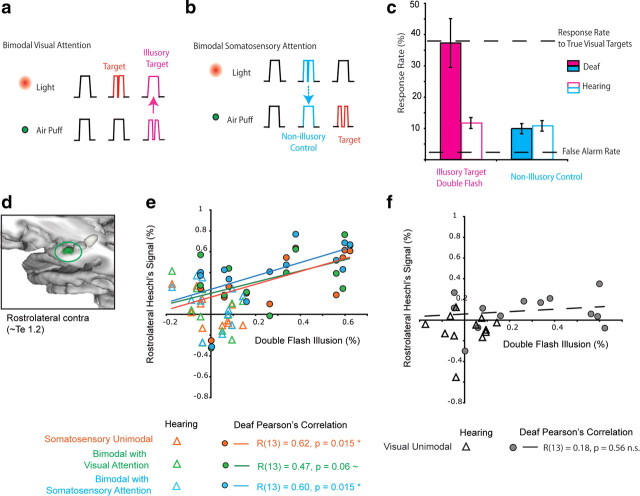Figure 8.
Somatosensory-induced double-flash illusion. a, In bimodal blocks, both lights and puffs were presented simultaneously. Targets were the double stimuli in the attended mode (double flash for visual attention, double puff for somatosensory attention), while double stimuli in the unattended mode were to be ignored. In Visual Attention blocks, a double light was the target whether paired with a single or a double puff, but if participants were susceptible to a somatosensory induced double-flash illusion, a single light paired with a double puff (illustrated in magenta) appeared to flash, eliciting a button press to the illusory target. b, In Somatosensory Attention blocks, a double puff was the target. A single somatosensory stimulus paired with a double visual stimulus does not generally elicit an illusory double touch sensation. The paired single-puff and double-light stimulus (illustrated in cyan) is perceived as a single puff and is considered a nonillusory control stimulus. This stimulus (illustrated in cyan) is still perceived as a single puff and is considered a nonillusory control stimulus. c, The ignored double puff in the visual attention condition (magenta) elicited a double-flash illusion in deaf but not hearing, while the double light in the somatosensory condition (cyan) did not elicit an illusory double puff in deaf or hearing. In the deaf, average response rates (± SEM) to the illusory stimuli were equal to their response rates to true visual targets. d, The rostrolateral subregion of Heschl's gyrus is shown highlighted in green. e, Signal change in the rostrolateral Heschl's gyrus for each block containing a somatosensory stimulus predicts the strength of the illusion in deaf adults. Pearson's correlations were calculated for the deaf participants only, separately for the ROI measures from each block containing a somatosensory stimulus. The relationship between signal change and the illusion was similar in all three blocks. All voxels in the anatomically defined region were included, not only those voxels thresholded for statistical significance. f, Signal change in the rostrolateral Heschl's gyrus for unimodal visual stimulation was not related to the strength of the illusion in deaf adults. Contra, Contralateral to stimulation.

